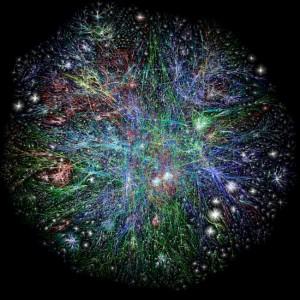It is sometimes said that animist worldviews are unitary, totalized, and seamless. What does this mean? At a first approximation, it means that such worldviews are distinctly and adamantly non-dualist. Animist worldviews neither recognize nor use a series of dichotomies that we tend to take for granted and which are prevalent, if not dominant, in modernist worldviews. These dichotomies include (but are not limited to):
- Nature/Supernature
- Physical/Metaphysical
- Matter/Spirit
- Material/Ethereal
In the absence of these dichotomies, the world presents — or rather is constructed as — a unity in which people, animals, landscapes, plants, things, ideas, and events are connected, even if the precise nature of those connections is unknown or mysterious. This seamless unity stands in stark contrast to the series of dualisms that mark Neolithic politico-religious formations and which dominate post-Neolithic or modern religions.
It is my contention that these conceptual dualisms arose in conjunction with and as a consequence of the Neolithic transition. The process, I contend, began with the newly built environment featuring the settlement and house. From this materiality flows ideas about inner/outer and private/public. In these seemingly innocent dualisms we find conceptual seeds that will eventually sprout into ideas about property, ownership, wealth, and distinction. From the early Neolithic through the post-Neolithic present, we find a multiplying or cascading series of dualisms on which everything will come – or be made – to rest. It is this constant sundering and splintering of things that so bewilders animists who are exposed to (or resist) Neolithicization.
As I read and understand the animist ethnographic record, this is what separates animist worldviews from the many different kinds of sociocultural and ideological formations that arise in Neolithic and post-Neolithic societies. This also explains why animist worldviews cannot be made to lie down on the procrustean bed of “religion.” It further explains why I contend that “religion” slowly originates out of the Neolithic transition and is particular to post-Neolithic societies. There is no such parceled and constructed thing as “religion” in the animist worldview. The only people who find “religion” in that worldview are those who conceive religion as a something like a natural, timeless, essential, and universal category.
There is today a growing and sophisticated body of research that is sometimes called the “new animism.” Considered in all its variety and as a whole, this scholarship describes a fully integrated and comprehensive way of being in, knowing about, and relating to the world. Animist worldviews make no distinction between the symbolic world of the mind and the physical world in which minds are embedded. Animist worldviews seamlessly bridge or join those worlds and thus literally and figuratively “make sense.” There is no “nature” that exists separate and apart from “supernature.” There is simply one reality, one world, and one cosmos. Everything within this unified cosmos – perception, thought, action, experience, and event – is connected and hence “real.” Animist worldviews are, in this sense, seamless, unitary, and totalizing.
While I would like to take credit for these ideas, I have done little more than piece them together from various sources. The intellectual godfather of this conception is Irving Hallowell, whose classic work (pdf) on Ojibway ontology paved the way toward this understanding of animist worldviews. His ideas were brilliantly extended by Nurit Bird-David and her understanding of these worldviews as a “relational epistemology” and the “cosmic economy of sharing.” Embedded within the latter is an “ethic,” which is a category and construct that modernists (and philosophers) usually treat as something separate and apart. This separateness is of course a legacy of dualism. Bruce Charlton, for his part, extended these ideas yet further by considering animist worldviews as a “relational ontology.” This ontological treatment is perhaps most brilliantly expressed in the work of Tim Ingold, whose “rhizomatic” understanding of animist worldviews is profound.
For those who want an “operational” analysis of animist ontology, Ingold’s analysis is the place to start. In a related vein, Philippe Descola brilliantly showed us that Amazonian animists (the Achuar) conceive what we call “nature” as society: the cosmos, therefore, is a singular culture. In a related line of work on “perspectivism,” originated by Eduardo Viveiros de Castro, we learn how and why it is that animals are ontological people or what Hallowell called “non-human persons.” There is a great deal more to this new animism, including work done by Calvin Luther Martin, Hugh Brody, Justin Smith, Robin Ridington, and Rane Willerslev. The collective upshot of all this is that animist worldviews are properly characterized as unitary, totalized, and seamless.
Given the radical differences between animist worldviews and modernist worldviews, it can be difficult to wrap your mind around them. The best way to do this is, in my estimation, to read long and deep in the hunter-gatherer Record. This will, of course, always result only in partial understanding because animist worldviews are lived and experienced in ways that elude capture through written records. They are deeply embedded in particular lifeways and oral tradition, in addition to being deeply embodied within ancestral or non-agricultural environments.


